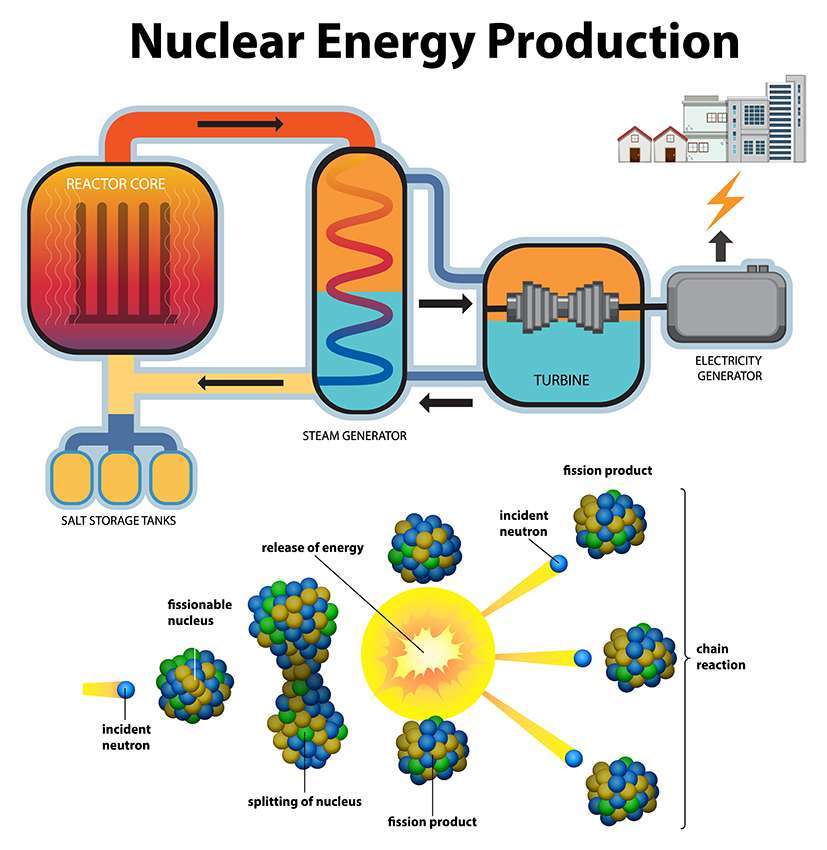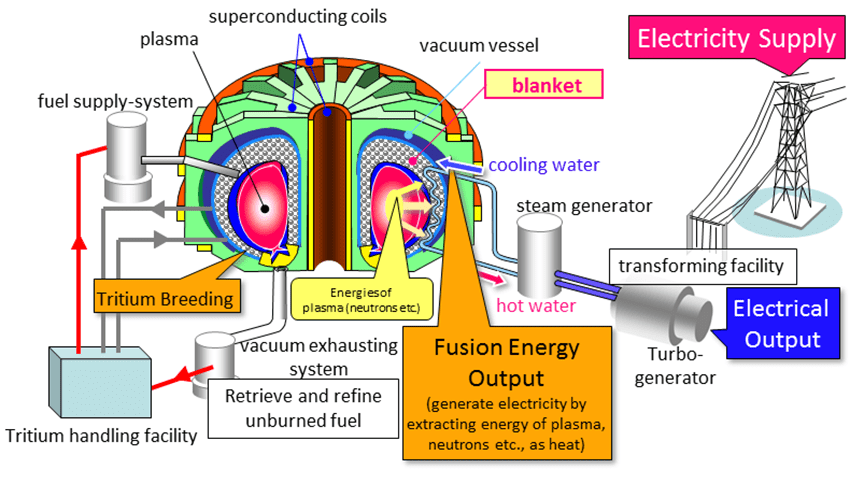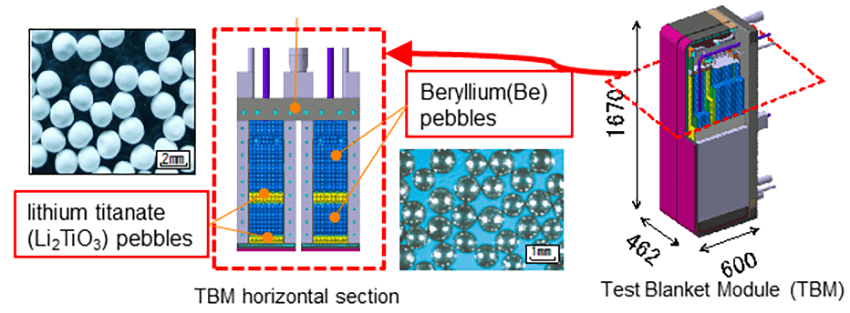It’s a bright, warm morning. I sit beneath the sun, on a little patch of dirt, in the backyard of the house where I rent a room, and I meditate. Rays of light caress my face. Within minutes, sweat condenses into rivers, saturating my clothing. However, it’s not just warm. In fact, it’s hot, really hot. A stray thought enters my head. It’s amazing that this incredible star which our planet revolves around, is so far away, yet it produces so much energy. Nuclear fusion is the process by which the sun creates energy. Using this process, it puts out an astounding 44 quadrillion watts of energy every year. In fact, that’s enough to power Earth and then some. This leads me to reflect on how breakthroughs in nuclear fusion could lead to a brighter future for all of us.
What is Nuclear Fusion?
In a reactor core, surrounded by hot plasma, Deuterium, an isotope of hydrogen, gazes at Lithium in her soft, white, and shiny metallic blanket. Deuterium arches an eyebrow and Lithium nods her head. Feeling compressed, they edge towards each other, sparking up a conversation. Deuterium is rude and Lithium slaps his face. In fact, she is repulsed, but not enough. The conversation restarts. They find that they are so attracted to each other that they fuse. In fact, the union is so powerful that energy is released and new babies appear.

Source: Image by brgfx
Hydrogen
Hydrogen is a gas that has one proton and one neutron. It is the most abundant atom in the cosmos. The isotopes of hydrogen make excellent fuel for nuclear fusion.
Deuterium
Deuterium is a stable isotope of hydrogen. Furthermore, it has one neutron, one proton, and one electron. It is an abundant isotope of hydrogen. In fact, 1 in every 5000 atoms in the ocean is deuterium. Furthermore, it is a key element to understanding breakthroughs in nuclear fusion. Deuterium is extracted from ocean water to make fuel that powers nuclear reactors. It’s not harmful because it’s not radioactive, making it a secure compared to nuclear fission.
Moreover, deuterium is a good choice for nuclear fusion because it releases more energy than other fusion reactions. Also, it achieves fusion conditions at temperatures lower than those required by other elements.

Source: Rokkasho Fusion Institute.
Lithium
Lithium weighs the least of the solid elements in the metal group. In fact, it has three protons, three electrons, and four neutrons. Within the nuclear fusion power plant there is a Lithium blanket surrounding the vessel containing the hydrogen isotope. Furthermore, this layer captures the energy released by fusion neutrons within the plasma through innovate design. In fact, it achieves this by heating water through a heat exchanger, generating steam to power a turbine, ultimately producing electricity. As a result, they create babies through the process of fusion between deuterium and lithium. Indeed, these babies are tritium and helium.

Source: Rokkasho Fusion Institute.
Tritium
Tritium is a radioactive isotope of hydrogen. It has two neutrons and one proton. Tritium occurs naturally in the Earth’s upper atmosphere when cosmic rays hit nitrogen molecules in the air. Furthermore, its formation happens when deuterium fuses with lithium inside the core of a nuclear reactor. Also, once bred within the core, deuterium and tritium can fuse together to produce energy.

Source: Rokkasho Fusion Institute.
Helium
Helium is gas that is non-toxic and non-radioactive. It has two protons, two electrons, and two neutrons. In fact, when fusion occurs, helium is another by-product of this process. However, it is not usable in nuclear fusion. In fact, people collect, store, and deliver it where needed. Helium’s uses include medical, such as MRI’s and lasers in eye surgery. Furthermore, different sectors utilise helium as a tracer gas to identify gas leaks in their products. Helium is a safe tracer gas due to its inert nature. However, nuclear fusion and other energy-generating activities do not use helium.
Breakthroughs in nuclear fusion: How is the electricity generated?
Electricity generation in nuclear fusion begins with the process of fusion reactions, where hydrogen nuclei are forced to fuse under extreme temperatures and pressure, resulting in the formation of helium and the release of a substantial amount of energy. This intense heat is then transferred to a circulating coolant, often a liquid metal or a molten salt, within the fusion reactor’s blanket. The coolant absorbs the heat from the fusion reactions, and this thermal energy is subsequently transferred to a separate water or gas loop through a heat exchanger. In this secondary loop, the heat converts the water or gas into steam, which, in turn, drives a turbine connected to a generator. As the turbine spins, it generates mechanical energy, which the generator transforms into electricity. This electricity is then integrated into the grid, becoming available for various applications and fulfilling power needs.
However, it’s important to note that despite significant advancements in fusion research, commercial fusion power plants are still in the experimental stage. Scientists and engineers continue to tackle various technical challenges, aiming to achieve sustained and economically viable nuclear fusion, which holds the promise of providing a virtually limitless and environmentally friendly source of electricity for the future. The breakthroughs in nuclear fusion they make will be the ones to power our lives for centuries.
Challenges
Nuclear fusion, though holding immense potential as a clean energy solution, confronts formidable challenges. The demanding conditions for sustaining fusion, involving extraordinarily high temperatures and pressures, present a significant hurdle. Achieving stability within the plasma, where fusion reactions occur, is also pivotal and requires innovative confinement methods. Additionally, balancing the energy input necessary to sustain fusion with the energy output is yet to be achieved, making many fusion experiments energy-negative.
Ensuring the durability of materials under the impact of high-energy neutrons generated during fusion reactions remains a pressing concern. Tritium supply and effective recycling methods are essential due to its scarcity and radioactivity. The economic viability of fusion technology, given its substantial costs, is a significant challenge, necessitating advancements to make it competitive with other energy sources. Addressing regulatory, safety, and environmental concerns are vital for the widespread acceptance and implementation of fusion technology. Despite these challenges, ongoing global efforts and advancements in research bring us closer to unlocking fusion’s potential as a sustainable energy solution.
moving forward
With further research and timely breakthroughs in nuclear energy it is viable that it will become a clean and sustainable energy source to power our futures. It is a natural process within the sun that is able to generate enough heat to keep our planet from freezing and plenty of electricity. Emulating that on Earth, through the controlled process of nuclear fusion in a reactor, is a possible solution to many of our energy issues.
The Importance of Breakthroughs In Nuclear Fusion?
Prioritising research and development in the field of nuclear fusion is imperative due to several compelling reasons. Firstly, fusion harnesses energy from isotopes of hydrogen, ensuring an abundant supply of fuel. Unlike fossil fuels, fusion is a clean energy source, emitting no greenhouse gases or pollutants, thus significantly reducing our carbon footprint. Moreover, fusion enhances energy security by decreasing reliance on finite fossil fuel reserves and mitigating geopolitical tensions related to energy resources. Safety is a paramount advantage; fusion reactions, unlike fission, inherently cease if something goes wrong, preventing catastrophic accidents.
Additionally, fusion produces minimal, short-lived radioactive waste, making waste management more manageable and less hazardous. Furthermore, fusion technology offers the potential for high energy output, capable of powering entire communities and even supporting long interplanetary journeys. Research in fusion also drives technological innovation, fostering progress not only in energy but also in various scientific disciplines. International collaborations, exemplified by projects like the International Thermonuclear Experimental Reactor (ITER), promote global cooperation and understanding among nations. Economically, investing in fusion research creates jobs, stimulates economic growth, and encourages innovation, making it a crucial driver for sustainable development. In essence, the focus on nuclear fusion represents a pivotal step toward a cleaner, safer, and more sustainable energy future.
achieving the United Nations Sustainable Development Goals (SDGs) and how they link to Breakthroughs In Nuclear Fusion
Nuclear energy has as much potential to liberate us from non-renewables as it does to generate power. Breakthroughs in nuclear fusion address several of the SDGs. These include:
- SDG 7 – “Ensure access to affordable, reliable, sustainable and modern energy for all.” Nuclear fusion contributes to Sustainable Development Goal 7 by providing a clean, abundant, and sustainable energy source, thereby ensuring affordable and reliable access to modern energy for all.
- SDG 9 – “Build resilient infrastructure, promote inclusive and sustainable industrialisation and foster innovation.” Nuclear fusion supports Sustainable Development Goal 9 by fostering innovation and infrastructure development, offering potential breakthroughs in clean energy technology and creating opportunities for sustainable industrialization.
- SDG 12 – “Ensure sustainable consumption and production patterns.” Nuclear fusion aligns with Sustainable Development Goal 12 by promoting responsible consumption and production, as it offers a sustainable, low-waste energy source, reducing the environmental impact associated with traditional energy production methods.
- SDG 13 – “Take urgent action to combat climate change and its impacts.” Nuclear fusion contributes to Sustainable Development Goal 13 by mitigating climate change, as it provides a carbon-free energy solution, helping to reduce greenhouse gas emissions and combat global warming.
A Thrivable Framework
Safeguarding human well-being in all domains is paramount to THRIVE‘s mission. This means advocating for, researching, and educating all who stumble across. Researchers need to conduct more studies on nuclear fusion to establish its safety and financial viability. Once approved, nuclear fusion can potentially propel us towards thrivability.
THRIVE’s logo, a ciambella chart, outlines two important boundaries for humanity to adhere to. These boundaries are – a social floor, denoting the minimum for an entity’s survival; and an environmental ceiling, where too many resources are taken from the environment. In conclusion, as research in nuclear fusion advances, it has the potential to provide a clean, reliable, and sustainable energy source for the future. By adhering to environmental boundaries and achieving thrivability, we can utilise nuclear fusion to meet our energy needs while reducing our impact on the environment. This innovative technology offers numerous benefits, from mitigating climate change to supporting global energy security and economic growth. As we focus on breakthroughs in nuclear fusion, we take a significant step toward a cleaner, safer, and more sustainable energy future.
To further discover THRIVE‘s well-researched treasures, educate yourself on our environmental stance, and familiarise yourself with our well-thought-out Systemic Holistic Model, please consider scrolling through our blog, subscribing to our YouTube channel, listening to our podcasts, attending one of our amazing webinars, or simply signing up for our newsletter.























